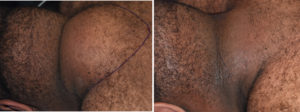One of the manifestations of the lipodystrophy syndrome is the Buffalo Hump deformity. While it occurs mostly in patients with HIV on antiviral medications, it can also be associated with chronic steroid use, such as in asthma patients. Occurring in both men and women, its predominant feature is the fat accumulation at the back of the neck and upper back. Fat accumulation can extend around the neck to the jawline and even around the ears. While unsightly, it also causes functional issues such as neck stiffness and pain and difficulty with the fitting of clothes around the neck.
Why this fat accumulation occurs is not precisely known, but it is a thickening of the subcutaneous fat layer between the skin and the underlying muscle or bone. This fat is unique in that it is very fibrous in quality, meaning it is a mixture of fat and scar tissue that makes it more difficult to remove than many other fat sites in the body.

Ultrasonic or laser-assisted liposuction can provide significant improvement but can not get all of the excessive fatty tissue. Expect improvement but not a complete cure of the problem. No long-term studies have ever been done that can substantiate how permanent the results from liposuction reduction of the buffalo hump are.
Fat around the front part of neck up into the face can be part of the buffalo hump or can also occur in Madelung’s disease. Open excisions of fatty tissue around the face, jawline, and ears works better than liposuction in my experience. The facial areas and front part of the neck are more difficult to treat with liposuction and usually less satisfying. Unlike liposuction, however, open excisions are associated with postoperative fluid collections (seromas) and the use of drains is needed. Open excision is done through a facelift type approach, placing the scars in the most favorable location.
Dr. Barry Eppley
Indianapolis, Indiana


